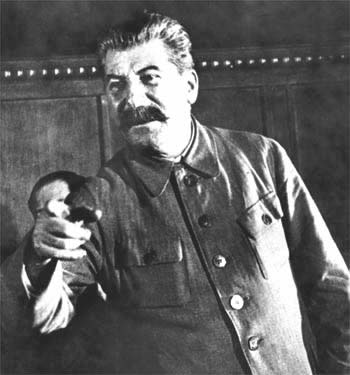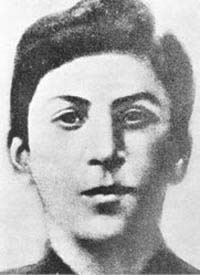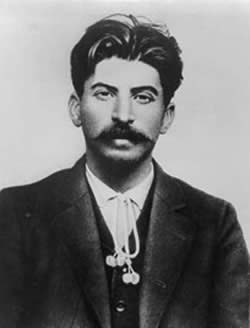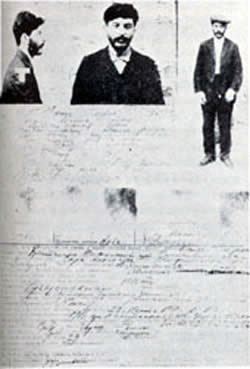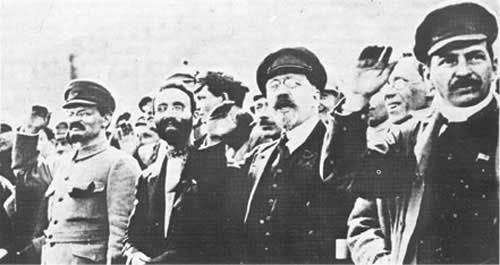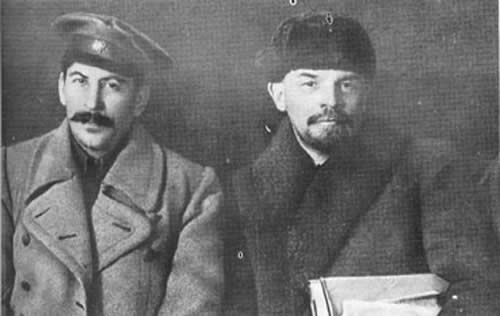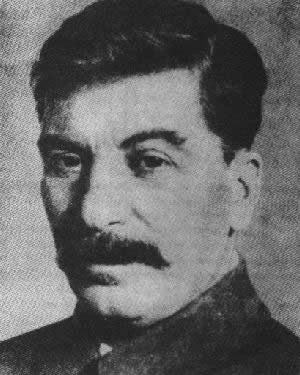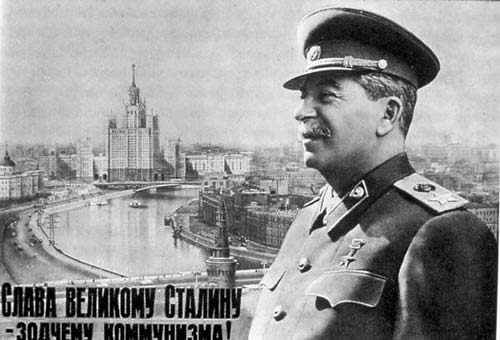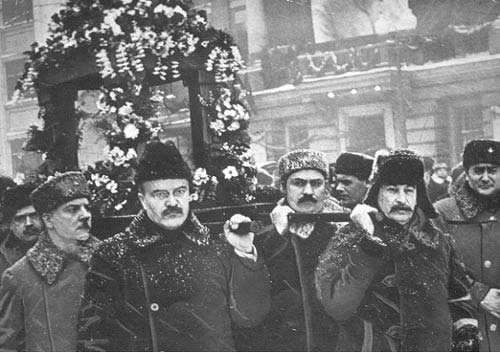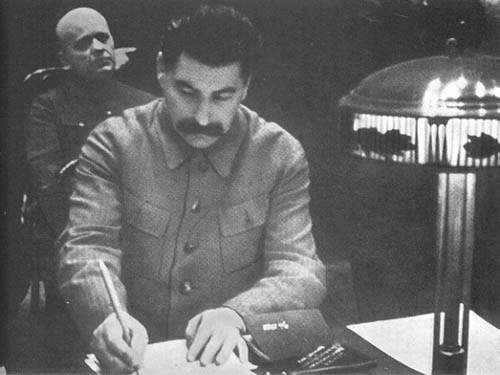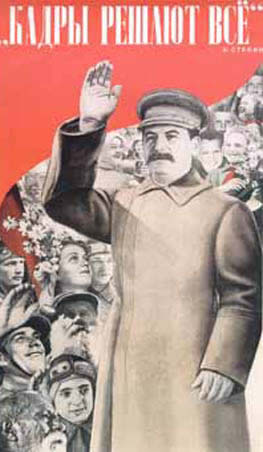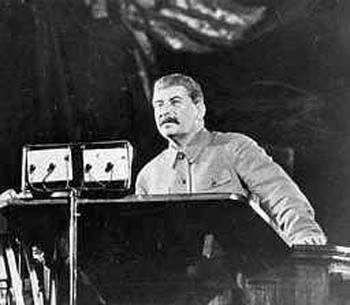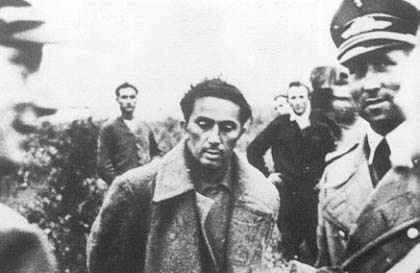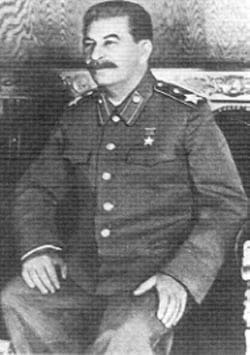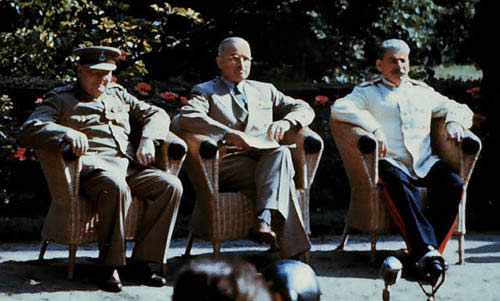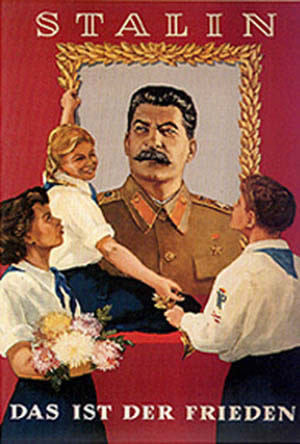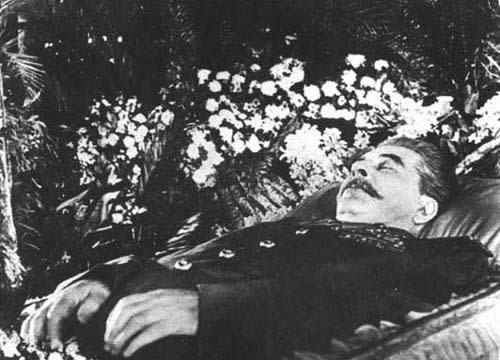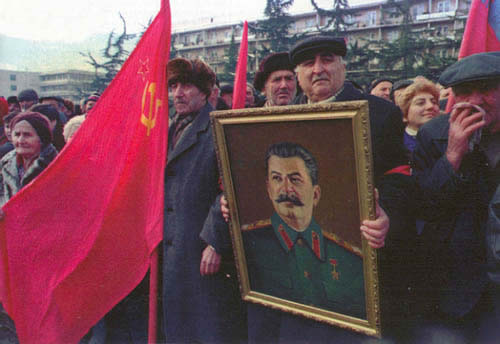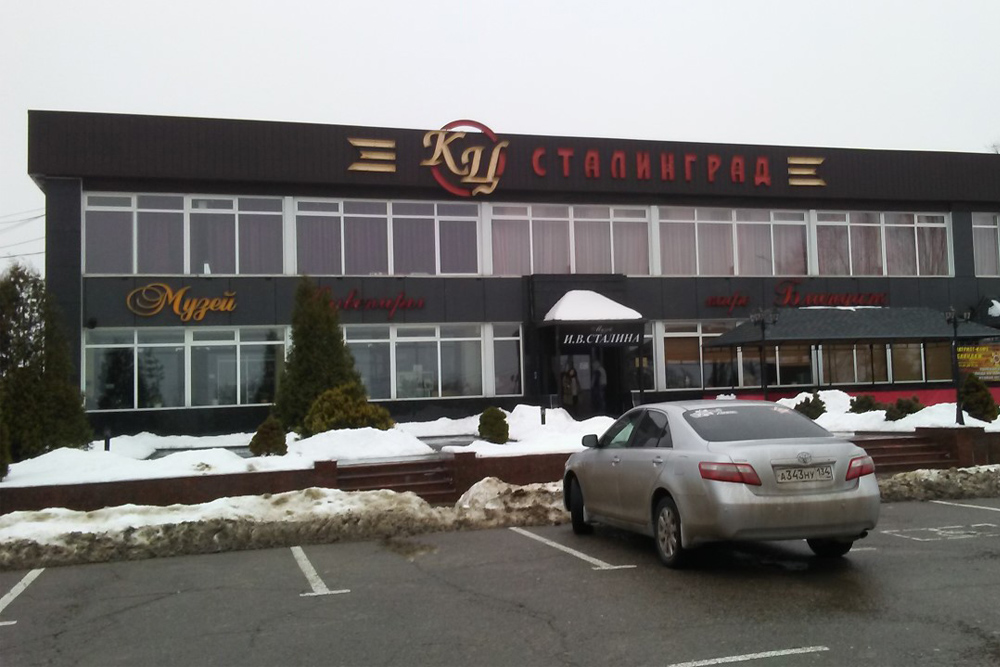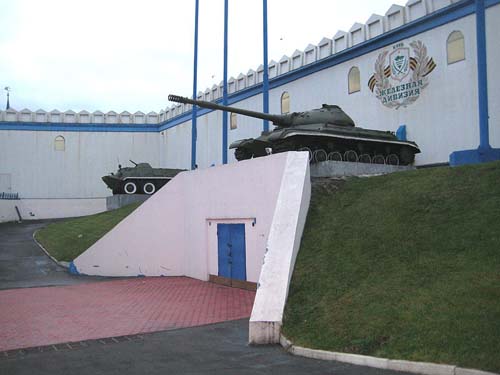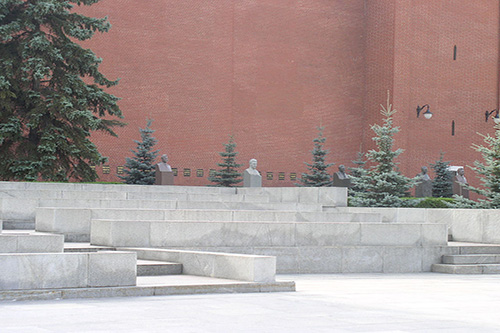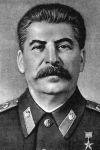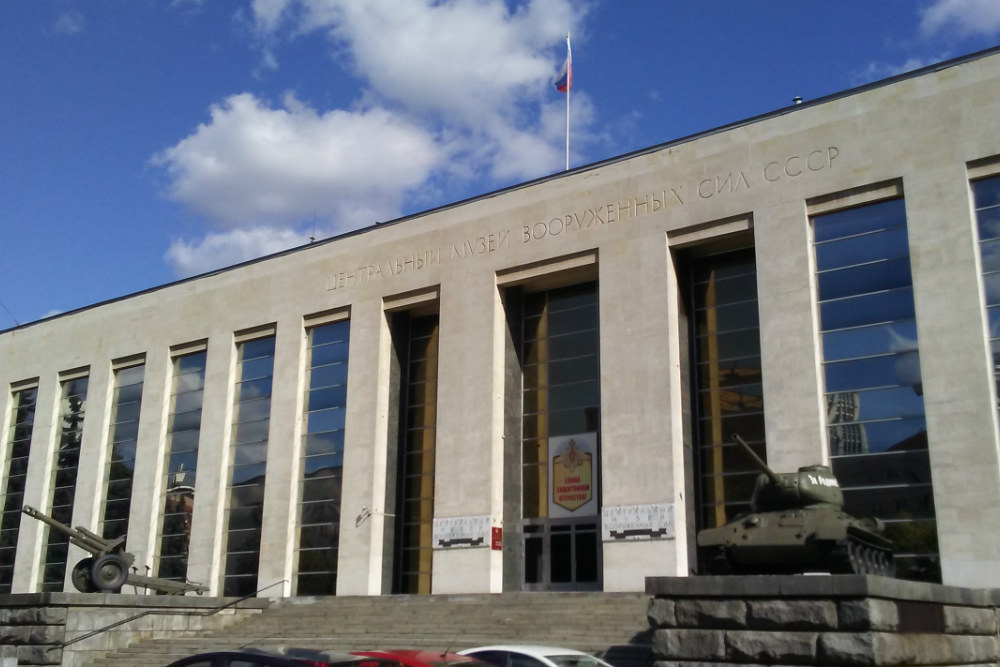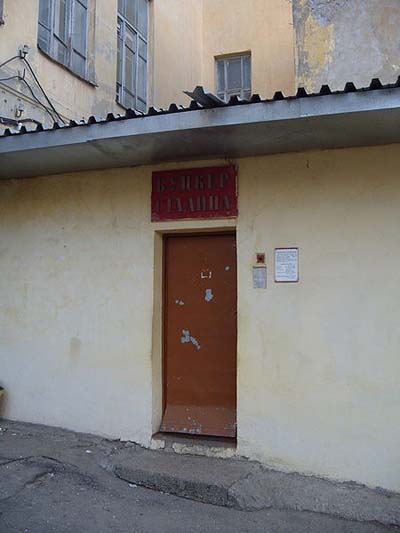Introduction
Joseph Stalin is undoubtedly one of the most spoken of statesmen of the 20th century. His successor Chrushev said after Stalin’s death: "Just like Peter the Great, he fought barbarism with barbarism," but Stalin was not only barbaric towards the German intruders. He also terrorized his own population to expand his authority. That way he let millions starve to death in the 30s, he had them murdered and deported to labor camps in Siberia.
The above does not mean that Stalin, by his determination and ruthlessness, was incapable of defeating Nazi Germany. He developed into the father figure of the Soviet population. In the early years of the Second World War, the West and the Soviet Union were committed to each other but as the outcome of the war shifted inevitably to the advantage of the western Allies, the distrust between the two increased; a distrust that would ultimately have a major impact on post war Europe.
Definitielijst
- Nazi
- Abbreviation of a national socialist.
- Soviet Union
- Soviet Russia, alternative name for the USSR.
Images
Stalin's childhood
Joseph Vissarionovich Dzhugashvili was born December 21st, 1879 (that is his official birthday by the way for there is still insecurity about his real birthday), in the Georgian town of Gori in the Caucasus. He was the only one out of four children to survive the bitter poverty of those days. His father, Vissarion Dzhugashvili was an unsuccessful shoemaker and therefore went to work in a factory. He was an incorrigible alcoholic though and Joseph Dzhugashvili was often beaten during his childhood. In 1890, his father died unexpectedly from injuries sustained during a skirmish in a bar. Stalin’s mother, Yekaterina was a very careful mother however. She was a housewife and nursed her son when he suffered from chickenpox and blood poisoning. As a result of this poisoning, Dzhugashvili’s left arm remained paralyzed for the rest of his life. Yekaterina was a very religious woman so she wanted Joseph to become a priest. Consequently, Joseph was sent to the orthodox clergy school in Gori in 1888.
Dzhugashvili turned out to be a good student and he graduated in 1894 with top marks. Afterwards he moved to Tbilisi where he enrolled in the Theological Seminar but Dzhugashvili detested the traditional religious education and became familiar with the Marxist ideology for the first time. In his fourth year he joined the Marxist movement Mesame Dashi which was a nationalistic Georgian grouping as well. Dzhugashvili made no secret of his Marxist ideas and as a result, he was expelled from the Seminar in May 1899. Dzhugashvili went to work as teacher of religion and as a clerk but he resigned in May 1901 for fear of being arrested for his Marxist notions. Despite the fact that he detested religious schooling, he was molded by it though. We’ll encounter that later on in his stoical, aloof and stern attitude.
Definitielijst
- ideology
- A collection of principles and ideas of a certain system.
Images
Dissident
In 1901, Dzhugashvili joined the Georgian Social-Democratic party and was continuously busy with tasks for this party, first in Tbilisi and later in Batumi. His task mainly consisted of organizing strikes and demonstrations. Dzhugashvili also wrote articles for local papers under a number of aliases, including the most successful, Koba after a Georgian folk hero and from 1913 onwards for the first time under the alias Stalin (man of steel). In 1901, his first article was published in the Georgian paper Brdzola (struggle), published in Baku. Stalin, as Dzhugashvili was called from then on, was arrested on April 18th, 1902 for the first time by the Czarist security service for having written these dissenting articles and was banished to Siberia in 1903. He managed to escape however and turned up again in Georgia in 1904.
Dzhugashvili developed an interest in social problems and the party organization; hence he joined a small group of Georgian socialists who embraced Lenin’s ideas. These ideas were known as Bolshevism and was essentially a disciplined, centrally led socialist party. Stalin helped to spread the Bolshevist ideology through the local press. For the time being, he had no important position in the party but he was present at the official establishment of the Georgian Bolshevist Organization in 1904 and at the third national congress of the Georgian Social-Democratic party.
In June 1904, Stalin married Yekaterina Svanidze, a simple farmer. They had a son, Jakov but Yekaterina died April 10th, 1907, leaving behind a disillusioned Stalin with a son.
Stalin’s career was pushed forward by the revolution of 1905 and he managed to rise to the highest circles of the nationalist movement. In 1905 he was employed as an organizer for the party and was editor of a Caucasian workers paper. Stalin was also involved in setting up raids on trains and government transports, providing the party with the money it needed badly. In 1907, Stalin moved his headquarters to Baku where he convinced the workers in the oil refineries of the Marxist ideology. Over the next four years, Stalin was very active politically, alternated by short periods of imprisonment and even a banishment to northern Russia. His most important achievement however was his presence as a delegate of the Caucasus at the first Bolshevist party congress in December 1905 in the Finnish Tammerfors. There he met Lenin for the first time.
In December 1911 Stalin was banished again, this time to Vologda. In January 1912, Lenin and his followers decided to separate themselves from the Mensheviks in the party. A meeting was arranged in Prague where a Central Committee was chosen. Stalin was not elected but nonetheless, Lenin gave Stalin an important position in his absence as one of the leaders of the underground movement in Russia. In March 1912, Stalin escaped from exile again and surfaced in Saint Petersburg where he helped set up Pravda (Truth), the new Bolshevist paper which appeared for the first time on May 5th 1912. Stalin and Lenin attended a number of party meetings abroad. In Austria, Stalin and Nikolai Bucharin put the Bolshevist ideas concerning ethnic minorities on paper. The work was entitled "Marxism and the national problem". On March 7th , 1913, however, Stalin was arrested again and deported to Siberia.
Stalin had entered the highest echelons of the Bolshevist wing of the party; not so because he excelled in intellectual capabilities but more so because Lenin needed a capable and above all a fanatic organizer he could trust. For the time being, Stalin remained unknown outside Lenin’s wing of the party and he did not play an important role in Georgia. Contrary to other prominent political leaders of the Bolshevists, Stalin had not lived abroad for long. Stalin was molded during his exile in Siberia from 1913 to 1917.
Definitielijst
- ideology
- A collection of principles and ideas of a certain system.
- revolution
- Usually sudden and violent reversal of existing (political) the political set-up and situations.
Images
Revolution and civil war
Meanwhile, Czar Nicholas II was involved in the First World War and with his armies, he waged a hopeless war against the Centrals(the German Empire and Austria-Hungary). The Russian population did not want war and moreover, a great famine prevailed. The morale of the Russian forces was low and defeat followed defeat, resulting in Russia losing much of her territory. Due to the wide spread unrest, the Czar abdicated on March 5th, 1917 and in consequence, an enormous social and political chaos erupted in Russia. A temporary government was installed, headed by a general of the Russian army.
In this situation, Stalin proved himself a great organizer in order to guarantee the Bolshevists a solid foundation. Lenin and his future archrival Trotsky saw to the rough outlines of the party, Stalin organized everything to the last detail. After his return to Saint Petersburg from exile on March 25th, 1917, he therefore went to work as editor of Pravda, which was headed at the time by Lev Kamenev. At the Bolshevist party congress on April 11th, 1917, Stalin advocated collaboration with the temporary government because of the uncertainty over the result of the expected revolution. Stalin was also elected, for the first time, to the nine-men Central Committee of the Communist party, ending third in the ranking.
After Lenin’s return to Russia, Stalin became convinced of the necessity of overthrowing the temporary government, of extricating the country from the Great War and most important of all, of continuing the revolution. Stalin played a modest role in this revolution but he was responsible, in the background, for the organization. He continued his work for Pravda and he arranged Lenin’s escape from Russia after the general rebellion in July. Moreover, Stalin was chairman of the sixth party congress due to the absence of the prominent leaders. During the discussions at the congress, Stalin strongly advocated Lenin’s leadership. He had, however, little to do with the seizure of power as such. That major role was allocated to Trotsky, the head of the Military Committee of the Supreme Soviet of Saint Petersburg.
Civil warIn the new Soviet regime (installed November 7th, 1917), Stalin was allocated a rather unimportant task. He was named People’s Commissioner of Nationalities and in that capacity he handled problems concerning the many ethnic minorities in the Soviet Union. He held this post for five years. His task entailed drafting laws and he also contributed to the drafting of the Constitution of the Soviet Union. Just like any other high ranking figure in the early days of the Soviet Union, Stalin held various posts within the regime from the outbreak of the revolution in 1918 onwards, including inspector of the Red Army and political commissioner of various fronts. He distinguished himself by the successful defense of Tsaritsyn (later renamed Stalingrad/Volgograd) against the White Army in 1918.
After the successful battle against the White Army in Russia itself, the Red Army advanced towards Poland. Stalin was also involved as political commissioner. The Red Army was defeated though and Stalin entered into a conflict with the army commander, Trotsky who considered Stalin his archrival from then on.
March 24th, 1919, Stalin got married for the second time, this time to Nadezha Alliluyeva, the 16 year old daughter of an old Georgian friend of Stalin, Sergei Alliluyeva. They had two children: Vasily (Bio Stalin V), 1919 and Svetlana, 1925.
Stalin’s real influence on the Soviet Union increased in the early years of the regime because he was one of the few members of the Central Committee who did not openly oppose Lenin’s actions. This gained him Lenin’s full confidence. Together with Lenin, Kamenev, Trotsky and Krestinski he made up the party leadership, better known as the Politburo. While the other prominent men were involved in politics, Stalin was mainly engaged in arranging party issues and he slowly made it to the highest ranks of the party organization. In 1919 he rose to chief of the Orgbureau, comparable to a modern internal intelligence service. Stalin was given authority to fire other party members and he made full use of it to eliminate his political opponents and replace them by his cronies. In 1922, Stalin rose to head of the party leadership itself in a new function, that of secretary-general. Consequently, Stalin had become a powerful man in the Soviet Union. Even before Lenin’s death, Stalin had formed a troika (three-man-team) with Zinovhev and Kamenev, initially in order to prevent the dissident Trotsky from taking power. Lenin had stated in his political will that Trotsky should become the new leader of the Soviet Union and that the other party members should attempt to eliminate Stalin. Stalin however managed to get possession of Lenin’s political testament and he took care that this document was not published, also because his party members did not like Trotsky at all.
Definitielijst
- collaboration
- Cooperation of the people with the occupying forces, more generally spoken the term for individuals who cooperate with the occupying force is collaborator.
- First World War
- Took place from 1914 till 1918 and is also named The Great War. The conflict started because of increased nationalism, militarism and neo-colonialism in Europe. Two alliances battled one another during the 4-year war, which after a dynamic start, resulted into static trench warfare. The belligerents were the Triple Alliance (consisting of Great-Britain, France, and Russia; later enlarged by Italy and the USA, amongst others) on the one hand and the Central Powers (consisting of Germany, Austria-Hungary, Bulgaria and the Ottoman empire) on the other hand. The war was characterized by the huge number of casualties and the use of many new weapons (flamethrowers, aircraft, poison gas, tanks). The war ended in 1918 when Germany and its allies surrendered unconditionally.
- Red Army
- Army of the Soviet Union.
- revolution
- Usually sudden and violent reversal of existing (political) the political set-up and situations.
- Soviet Union
- Soviet Russia, alternative name for the USSR.
Images
Seizure of power and collectivism
After Lenin had died in 1924, Stalin actually became the most powerful man in the Soviet Union. In the struggle for the course of the Communist movement in the 20s, Stalin took a resolute stand against Trotsky who still wanted to introduce socialism in the entire world. Instead, Stalin proclaimed "Socialism in one country" in 1925. This also alienated Zinovhev and Kamenev from him; after their defeat at the 14th party congress, manipulated by Stalin, they teamed up with Trotsky, who had been stripped of all his power in the meantime, in the so called united leftist opposition. Stalin however managed to silence them within two years, aided by the right wing of the party, headed by Bucharin.
On occasion of the celebration of the 10th anniversary of the Soviet regime in 1927, Stalin already appeared as generally acknowledged party leader. His decision of 1928 to industrialize the Soviet Union and collectivize agriculture at increased speed, a goal his defeated opponents on the left had advocated for years, alienated him from the right wing which wanted to continue the moderate policy. Subsequently, the right wing politicians who did not dare to oppose him openly, were shoved aside step by step until they were forced to acknowledge in humiliating self criticism they were wrong.
CollectivizationOnce Stalin had seized full power in the Soviet Union, he almost immediately introduced a restructuring of agriculture and the industry. Before Stalin’s first Five-Year-Plan became effective in 1929, the Soviet Union pursued a mixed economic policy (New Economic Policy, introduced by Lenin in 1921 in order to restore the economy after the civil war) with a market in which farmers, small manufacturers and traders could operate according to traditional capitalist rules.
Stalin was convinced however that the Soviet Union was lagging far behind the West and he did everything possible to close that gap as soon as possible by modernizing industry and agriculture. Kulaks (rich farmers and owners of real estate) were forced to hand over their land to large collective farms (Kolkhozes) owned by the State. The collective farms confiscated the harvest and the farmers had to try and survive with the leftovers. The population resisted fiercely against Stalin’s policy, causing a wave of terror by the police spreading over the Soviet Union. Between 1932 and 1934, allegedly millions of people lost their lives in resisting Stalin’s plans. Executions were a daily occurrence but most victims had starved to death. Moreover, nationalist sentiments prevailed among the population of the Ukraine which Stalin had had ruthlessly stamped out by means of a systematic terror by the police. Stalin had the Soviet population suppressed by OGPU, the security service which was restructured in 1934 and renamed NKVD. The NKVD was headed by Yagoda, a dedicated follower of Stalin who carried out the orders of the Secretary-general.
These measure were all part of Stalin’s first Five-Year-Plan, demanding deliveries that were simply impossible to meet. In this way, many farmers lost their work, causing massive migration from rural areas to the cities in the Soviet Union. These relocations also often took place under duress from the NKVD.
Collectivization of the industry was also introduced in the cities. Factories were forced to attain almost impossible production volumes. In Moscow alone, 5 million officials were engaged in setting production targets and supervising factories. Failure to meet the required goals was severely punished. Workers were forced to work overtime and on resisting, these people were usually deported to the Gulags (labor camps) in Siberia where they had to do forced labor and usually died of starvation and exhaustion. Due to the excessive workload, manufactured goods were usually of poor quality. This also explains why large numbers of tanks of the Red Army broke down in the beginning of the Second World War. This meant however that those gigantic production volumes enabled the Soviet Union to defeat the Wehrmacht during the war. Just like Hitler had his highways (Autobahn) and his colossal Nazi buildings constructed during the second half of the 30s, Stalin likewise had his own architectural prestigious projects. In the early 30s, he started the realization of a gigantic subway network beneath the centuries old city of Moscow. Furthermore, thousands of miles of railway tracks were laid and channels dug in order to improve the infrastructure of the rapidly growing Soviet State.
The terror by the police was systematically expanded and official Stalin glorification was thrust upon the people. Despite these conditions, Stalin faced problems in his private life. His second wife committed suicide and left Stalin a letter, blaming him for the wave of terror that washed over the Soviet Union. Some of Stalin’s close associates later claimed that this was his reason to further expand his terror.
Definitielijst
- Nazi
- Abbreviation of a national socialist.
- Red Army
- Army of the Soviet Union.
- socialism
- Political ideology aiming at slight or no class differences. Means of production are owned by the state. Evolved as a response to capitalism. Karl Marx tried to substantiate socialism scientific.
- Soviet Union
- Soviet Russia, alternative name for the USSR.
- Wehrmacht
- German armed military forces, divided in ground forces, air force and navy.
Images
The Great Terror
When in 1934 it looked like a majority in the Politburo wanted to curb Stalin’s personal rule somewhat, Stalin launched the so called Big Terror (1934-1938), triggered by the murder of his most prominent opponent Kirov, which was orchestrated by the police. High ranking political opponents such as Kamenev and Zinovhev were frequently publicly persecuted in humiliating kangaroo trials. In addition to political opponents, numerous loyal officials of the party and the state, artisans, scientists and civilians charged with espionage, treason and Trotskyism were executed or imprisoned in penal colonies. Stalin continuously felt threatened. He saw reactionary instigators and saboteurs everywhere. If something went wrong somewhere, he simply could not believe it was an accident; it must have been sabotage. Stalin even had a large number of his in-laws eliminated as he considered them enemies of the state.
The Red Army did not escape Stalin’s cleansing either. Stalin greatly despised professional officers. Assisted by the NKVD, headed by Lavrenty P. Beria (Bio Beria), also known as Stalin’s meat mincer, Stalin had the better part of the military top eliminated, including three out of the five marshals he had appointed himself, 13 out of the 15 army commanders, 110 out of the 195 division commanders and hundreds of thousands lower ranking officers. The most prominent soldier who was murdered was Marshall Tukhachevsky who had been responsible for the modernization of the Red Army in the early 30s. Tukhachevsky had developed a strategy which would prove highly effective in a later phase of the Second World War. Tukhachevsky was suspected of being a follower of Trotsky who had long since been banished. Other sources mention a German conspiracy, headed by Tukhachevsky. Stalin replaced the military top by veterans of the 1st Cavalry Army of the Civil War, old cronies of his such as Kliment E. Voroshilov, Semyon M. Budjonny and Semyon K Timoshemko. The cleansing had a devastating effect on the organization, offensive power and morale of the Red Army.
Stalin did seize ever more power. To that end, he habitually used the propaganda machinery. The glorification of Stalin was evident in the cities named after him (Stalingrad, Stalinogorsk) and the number of paintings, statues and other images, usually portraying him as a superman or a child’s friend. Stalin also had many photographs tampered with. He had persons deleted from pictures when they had been eliminated or had himself added if he wanted to have been somewhere. Movies were also made with him in a hero’s role, such as the storming of the Czar’s palace in Leningrad during the revolution, although Stalin himself was not even present at the time. In school books too, the population of the Soviet Union was told the revolution had been a success because of Stalin’s involvement. Moreover, Stalin’s birthdays were being celebrated exuberantly with massive military parades in the Red Square in Moscow.
During his reign, Stalin hardly ever appeared in public. He always had a small group of people around him. Stalin spent most of his time doing paperwork, he slept little and resided most of the time at night in the subterranean quarters beneath the Kremlin. Contrary to Hitler, Stalin was no great orator and seldom showed up outside the Kremlin. As Stalin hardly ever appeared in public, the Soviet population lived with the assumption that Stalin had nothing to do with and did not know anything about the cleansing.
Definitielijst
- Cavalry
- Originally the designation for mounted troops. During World War 2 the term was used for armoured units. Main tasks are reconnaissance, attack and support of infantry.
- Kremlin
- Soviet administrative centre in Moscow.
- offensive
- Attack on a smaller or larger scale.
- propaganda
- Often misleading information used to gain support among supporters or to gain support. Often used to accomplish ideas and political goals.
- Red Army
- Army of the Soviet Union.
- revolution
- Usually sudden and violent reversal of existing (political) the political set-up and situations.
- Soviet Union
- Soviet Russia, alternative name for the USSR.
- strategy
- Art of warfare, the way in which war should be conducted in general.
Images
The Second World War
From the establishment of the Soviet Union onwards, the western powers had been wary about the socialist dictatorship. When Hitler seized power in 1933, the anti-Bolshevist mood in Germany was stirred up further. Mutual tensions between Germany and the Soviet Union increased. Stalin therefore faced a difficult choice: either enter into an alliance with the west or with Germany. Moreover, Stalin feared the west and the Nazis would jointly take up arms against the Soviet Union. Owing to the strenuous negotiations with the western powers, Stalin opted for Germany and in 1939, a non-aggression treaty was signed, the notorious Molotov-Von Ribbentrop Pact (see Pact 23-08-1939).
The partitioning of Eastern Europe was agreed upon in a series of secret clauses, expanding the Soviet sphere of influence further west. The Red Army marched into eastern Poland in 1939 and subsequently, the winter war against Finland took place which ended dramatically for the Soviet Union. In 1940, Germany scored unheard of successes, overrunning almost all of Western-Europe with the exception of Great Britain. In 1941, Hitler decided the time had come to attack Germany, despite the non-aggression treaty.
Despite a multitude of warnings, Stalin did not see Hitler’s real intentions when German troops invaded the Soviet Union on June 22nd, 1941. Initially he refused to let his troops fight back and ordered them not to react to German provocations. It soon dawned on him however what Germany’s real German motives were and Stalin ordered a general mobilization.
Due to the cleansings and the command structure, the Red Army suffered defeat after defeat however. Millions of Soviet soldiers died or were taken prisoner of war. Stalin was deeply shocked over the German victories. He was the only war leader who had his commanders executed for having failed to reach their military objectives. For instance, General Dmitry G. Pavlov, the commander of the Soviet forces in Byelorussia suffered this fate.
Stalin called on the population to apply the scorched-earth tactic, launch actions by partisans and evacuate the industry eastwards beyond the Ural mountains. He also exhorted the population to wage a Great Patriotic War, not even mentioning the Communist ideals, arguing that the common soldier would rather fight for Mother Russia than for Communism. Emulating his law on freedom of religion, passed in 1936, he roped in the church, intending to further fuel the patriotism of the population.
In July 1941, Stalin’s eldest son Jakov - who served in the 14th Artillery Regiment - was taken prisoner by the Germans near Vitebsk. Earlier on, Stalin had decreed that each soldier who fell in German hands alive, was a traitor to his country. The Nazis attempted to set up Jakov against his father but Stalin’s son proved to be a man of steel as well. Early 1943, the Germans proposed via the Red Cross to exchange Jakov for Friedrich Paulus (Bio Paulus), the German field marshal of 6th Army who had fallen in Soviet hands after the surrender at Stalingrad. Stalin refused, stating that a field marshal could not be exchanged for a lieutenant, causing Jakov to throw himself onto the barbed wire at Sachsenhausen concentration camp.
Forced by the initial catastrophic defeats, Stalin approached the western Allies for help. A month after the German invasion, Stalin requested Churchill (Bio Churchill) to open up a second front in Europe.
Almost immediately after the German invasion, Stalin changed the command structure of the Red Army by installing an advisory agency, the five men strong State Defense Committee or Stavka. At the same time he appointed himself People’s Commissioner of Defense and supreme commander of the armed forces although he had already let himself be appointed prime minister prior to the invasion. Stalin commanded the Red Army from his subterranean bunker beneath the Kremlin and was in direct contact with the army commanders, giving them instructions from Moscow. He literally commanded the front in fact. In the early years of the war, Stalin ignored the advise of his generals with disastrous consequences. But contrary to Adolf Hitler, Stalin learned from his mistakes and after the victory at Stalingrad, he left the best part of military planning to his military commanders. In 1943, Stalin was awarded the title Marshal of the Soviet Union and in 1945 even the weird title Generallissimo.
After the battle for Moscow in the winter of 1941 and the Soviet victories at Stalingrad and Kursk in 1943, the tide turned however and the Red Army went onto the offensive towards Germany.
At the two large international conferences, first in Teheran in 1943 and later in Yalta in 1945, Stalin had one goal only: to improve the safety of the Soviet Union by expanding her sphere of influence westwards. Moreover, he desired the unconditional surrender by Germany. Stalin was a negotiator as hard as iron and managed to achieve many of his goals. He was often at odds with Churchill however, causing the mistrust between east and west to intensify.
The Allied landings in Normandy took the German pressure off the eastern front and Stalin had the Red Army commence the advance to Berlin as he wanted to conquer the city before the Allies did.
The Germans suffered a crushing defeat and in the spring of 1945, the battle for Berlin was launched where Stalin set his most prominent military commanders, Marshals Ivan S. Konev (Bio Konev) and Gheorghi K. Zhukov up against each other. The race to Berlin was all about who would be the first to hoist the Red Flag on the Reichstag building. A large number of Soviet soldiers died unnecessarily as a result of Stalin’s hunger for prestige. The race progressed as a dead heat but Stalin decided at the last moment Gheorghi K. Zhukov (Bio Zhukov) was allowed to finish the job.
Definitielijst
- Communism
- Political ideology originating from the work of Karl Marx “Das Kapital” written in 1848 as a reaction to the so-called class struggle between the proletariat (labourers) and the bourgeoisie. According to Marx the proletariat would take over power from the well-to-do classes though a revolution. The communist movement aspires an ideal situation where the means of production and the means of consumption are common property of all citizens. This should end poverty and inequality (communis = common).
- concentration camp
- Closed camp where people are being held captive that are considered to be anti- social, enemies of the state, criminal or unwanted individuals. These groups mostly do not get a fair trial or are condemned to doing time in a camp.
- dictatorship
- A form of government where the power in a country is in the hands of one person, the dictator. Originally a Roman regime in case of an emergency where total power would rest with one person during six months in order to face a crisis.
- Great Patriotic War
- Soviet and Russian term for World War 2.
- heat
- High-explosive anti-tank warhead. Shaped charge projectile to punch through armour. Used in e.g. bazooka or in the Panzerfaust.
- invasion
- Armed incursion.
- Kremlin
- Soviet administrative centre in Moscow.
- marshal
- Highest military rank, Army commander.
- mobilization
- To make an army ready for war, actually the transition from a state of peace to a state of war. The Dutch army was mobilized on the 29 August 1939.
- offensive
- Attack on a smaller or larger scale.
- Red Army
- Army of the Soviet Union.
- Regiment
- Part of a division. A division divided into a number of regiments. In the army traditionally the name of the major organised unit of one type of weapon.
- Reichstag building
- German government building in Berlin.
- second front
- During World War 2 the name of the front that the American and Brits would open in the West to relieve the first Russian front.
- Soviet Union
- Soviet Russia, alternative name for the USSR.
- Stavka
- The high command of the Russian military forces in World War 2, chaired by Stalin.
Images
The Cold War
For the post war period, Stalin envisaged nothing else but a stronger and safer Soviet Union. For the duration of the war, up to the defeat of Japan, he accepted co-operation with the western Allies. At the Potsdam conference, there still was a semblance of friendship but it ended there. Stalin’s vision was determined by the Cold War from then on.
Stalin expanded his sphere of influence by establishing Communist regimes in almost all of eastern Europe, in fact supervised by Moscow. This power structure would remain in force until the 90s of the previous century when the Communist states in eastern Europe ceased to exist, including the Soviet Union itself.
Tensions between the Soviet Union and the United States increased, in particular after the Soviet Union had managed to develop a nuclear weapon. It was one of the reasons why Stalin partly maintained his war economy; moreover, keeping the armies of occupation in eastern Europe was very expensive. Stalin wanted to keep Berlin for himself and had the supply lines from western Germany to Berlin blocked in order to starve the city. The United States responded by opening an air lift to Berlin in order to provide the citizens with their means of sustenance.
1950 saw a indirect collision with the United States during the Korean war. Stalin wanted to expand his sphere of influence further and provided the North-Koreans with weapons and military advisors. During the negotiations with the western powers, Stalin attempted to stop the ‘westernization’ of western Germany, amazingly enough by urging a unification of Germany which was to continue under Communist rule in exchange for a peace treaty with the United states. The U.S. however did not approve.
At home, Stalin continued his cleansing after the war but on a more limited scale than in the 30s. Influential soldiers from the war like for instance Marshal Gheorghi Zhukov were transferred to far away garrisons or even stripped of their functions. Entire populations were deported to the east, including Tatars, Kalmuks and Chechnya’s as they had, according to Stalin, collaborated massively with the Germans. German prisoners of war were also deployed as slave laborers in Siberia. Strangely enough, returning former Soviet prisoners of war were also deported to Siberia. Stalin accused them of treason because they had not fought to the death and considered them spies because they had spent a long time in the west. During World War Two, many Russians, Ukrainians and other ethnic groups had fought alongside the Germans. For those, Stalin had no mercy whatsoever. Many of them were executed out of hand and the rest was deported to Siberia. Shortly before his death, Stalin had a plan ready for a new Great Terror among many influential soldiers and other loyal persons around him. Stalin also distrusted the Soviet Jews, in particular after the establishment of the state of Israel. Stalin embraced the age old prejudice of the Jew being a capitalist scoundrel. For these people, Stalin’s death came right on time after all.
Definitielijst
- Jews
- Middle Eastern people with own religion that lived in Palestine. They distinguished themselves by their strong monotheism and the strict observance of the Law and tradition. During World War 2 the Jewish people were ruthlessly persecuted and annihilated by the German Nazis. . An estimated 6,000,000 Jews were exterminated.
- Marshal
- Highest military rank, Army commander.
- Soviet Union
- Soviet Russia, alternative name for the USSR.
Images
His death and de-Stalinization
In 1953, Stalin had a hemorrhage and was unable to perform his daily tasks. He was taken care of in his country residence. The physicians surrounding himself were very afraid to make mistakes as Stalin was still capable of giving orders that could cost them their lives. Ultimately, Stalin died March 5th , 1953 from a new hemorrhage. Any way, that was the official announcement in the Soviet Union. There are sources that have their doubts about Stalin’s real cause of death, up until today, rumors still circulate to the effect that Stalin had been poisoned.
Be it as it may, on March 6th, 1953, the Soviet radio announced the death of Stalin. The Soviet population was in deep mourning which is not strange after 26 years of glorification. Many Soviet citizens had no idea how to handle the situation, they could hardly believe their leader had passed away and there was general concern how the country was to continue. Nikita Chrushev succeeded Stalin as Secretary-general of the Communist party.
After a huge ceremony, Stalin’s embalmed remains were entombed in the mausoleum on the Red Square in Moscow, next to Lenin. After it had finally become a little more clear what Stalin had caused his remains were removed from the mausoleum, subsequently cremated and finally his ashes were placed in the wall of the Kremlin.
de-StalinizationIn 1956, Chruschev delivered a secret speech at the Communist party congress, announcing the glorification of Stalin had to be stopped; at the same time he fired Stalin’s most trusted associates like Vyacheslav M. Molotov (Bio Molotov). As a result of this deStalinization, statues and paintings of Stalin were removed from public places. Reports about Stalin in the Soviet press and the satellite states changed as well. Dissidents and German prisoners of war were set free. Chruschev saw to it that the influence of the NKVD on society was limited and the inhabitants of the Soviet Union enjoyed more freedom. The Soviet Union remained a totalitarian state however. These measures did result in uprisings erupting in Hungary and Poland which were ruthlessly suppressed by the Red Army.
Public reporting about Stalin’s terror only became possible when Gorbatshov came to power in the Soviet Union in the 80s. Then it really became clear to the population what had happened during Stalin’s reign of terror but even today, some Russians and Georgians still glorify Stalin.
Definitielijst
- Kremlin
- Soviet administrative centre in Moscow.
- Red Army
- Army of the Soviet Union.
- Soviet Union
- Soviet Russia, alternative name for the USSR.
Images
Information
- Article by:
- Tom Notten
- Translated by:
- Arnold Palthe
- Published on:
- 19-01-2025
- Feedback?
- Send it!
- 06-'42: Along the Battle Fronts
- 06-'42: Editor's Postscript
- 03-'44: The War in the Air
- 07-'44: Miracles of Planning Behind the Great Invasion
- 07-'44: The War at Sea
- 05-'45: Dramatic Last Days of the War in the West
- 07-'45: Secret Service Agents Helped to Win the War
- 08-'45: Russia Smashes In to End the War With Japan
The War Illustrated
Related sights
Sources
- Alliloejewa, Swetlana: Twintig brieven aan een vriend. De herinneringen van Stalins dochter. Amsterdam, Elsevier, 1967, - Deutscher, Isaac: Stalin: Een politieke biografie [2 delen], Hilversum, De Boer, 1963, - Besymenski, Lew: Stalin und Hitler. Das Pokerspiel der Diktatoren. Berlin, Aufbau Verlag, 2002, - Bullock, Alan: Hitler and Stalin, Parallel lives. London, Harpers & Collins Publishers, 1992, - Kromhout Bas: Stalin: Dictator met idealen'. Historisch Nieuwsblad, februari 2003, - Martens Ludo: Een andere kijk op Stalin. Antwerpen, EPO, 1994, - Radzinsky, Edward: Stalin, onthullingen uit geheime privé-archieven. Amsterdam, Uitgeverij Balans, 1996, - Taylor A.J.P:De Oorlogsbazen. Ede, L.J. Veen, 1979, - Volkogonov, Dimitri A: Triomf en tragedie: Een politiek portret van Josef Stalin. Houten, De Haan, 1990.
